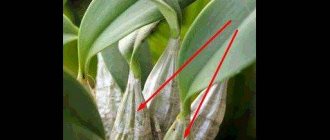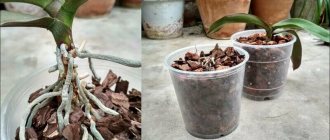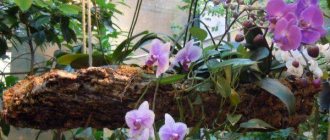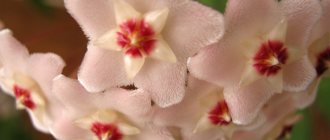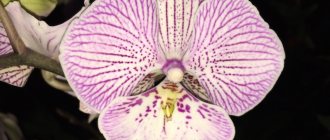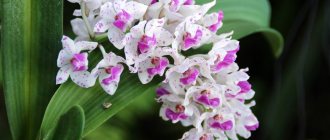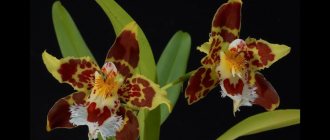Description
The Singolo orchid is a popular hybrid, the peculiarity of which is the formation of only one large flower on the peduncle . Most often the flower is white or purple in color. Other colors are often found.
An adult plant reaches a height of no more than 30 cm. Leaves form on the stem in an amount of 3 to 6 pieces, width from 8 to 13 cm, length up to 18 cm. The structure of the leaves is fleshy and dense. The shape of the flower resembles a fluttering butterfly or moth , and its size during the flowering period can reach 15 cm.
Phalaenopsis varieties
Charming blue butterfly orchid
Breeders have been breeding new varieties of the royal flower for a long time. Among them there are very rare plants. They cost a fortune.
For those new to growing, hybrids are recommended. They are easy to care for and do not require close attention.
Pleasant or Amabilis
Phalaenopsis Amabilis: white flowers with a light lilac coating on the edge of the petal
Pleasant or Amabilis
The fleshy leaves of phalaenopsis are dark green in color, arranged in 2 rows. The peduncles are long, curved in shape, and can reach 0.5 m in length.
A replacement peduncle immediately develops in place of the cut peduncle. Phalaenopsis Amabilis is a fertile material for crossing. It is this beauty that is the progenitor of many new varieties.
Flowering is long lasting. Flowers appear mainly in autumn.
Pink (Rosea)
Pink (Rosea)
Pink (Rosea)
It is considered a miniature plant. Bright pink or white flowers do not exceed 3 cm in diameter and are located on a peduncle 30 cm long.
Schilleriana
Schilleriana
Schilleriana
The beautiful exotic foliage is completely covered with silvery spots, the bottom of the leaf has a reddish tint. Huge flowers, reaching a diameter of 7 cm, hang in a beautiful cascade from long peduncles. Stems can be 0.5 m long.
Stuart (Stuartiana)
Stuart (Stuartiana)
Stuart (Stuartiana)
An interesting plant with variegated foliage and silvery roots. The variety has gained popularity due to its abundant flowering: up to 60 snow-white flowers decorated with purple spots can bloom simultaneously on one peduncle.
Phalaenopsis Cleopatra
Phalaenopsis Cleopatra
Phalaenopsis Cleopatra
An unpretentious hybrid variety with beautiful yellow flowers. The entire surface of the petals is generously dotted with burgundy specks. The flowers are large.
Phalaenopsis hybrids have an affordable price, varieties are a little more expensive.
Currently, orchid collectors are in pursuit of pelorics. This is the name of a variety of orchids (mutants) that bloom differently each time.
What flowers should you not keep at home and why? TOP 25 plants dangerous to health + Signs | (25+ Photos & Videos)
First mention
In 2014, Opti-flor presented the Singolo orchid for the first time at a breeders' fair in Germany. After demonstrating the new product, many experts noted a number of differences from other types. The main ones include:
- Mostly one-color color.
- Large flower (provided one peduncle is left).
- The shape of the leaves is slightly wider than usual for phalaenopsis, and they form quite quickly.
- Root system. Singolo has short and fairly thick roots.
External characteristics of Phalaenopsis Kaleidoscope
It is difficult to pass by and not notice a beautiful orchid 70 cm high and an inflorescence of bright 9 cm flowers.
This is a substantial orchid, it loves to be the center of attention and does not tolerate crowded spaces, so you won’t be able to save space with it.
Phalaenopsis leaves are smooth, dark green, fleshy, and well textured. They are large and long, more than 25 cm. They tend to grow fan-shaped, so the flower cannot be limited on any side.
The kaleidoscope is distinguished by the rapid growth of airy, spider-leg-like roots sticking out in different directions. They are powerful and strong.
The flower is dense in texture, with a light velvety surface of orange-yellow shades
The kaleidoscope orchid is shaped like a butterfly fluttering in the tropics.
Recently, on European forums, some experienced flower growers have been disputing the fact that phalaenopsis kaleidoscope has no smell. They claim that a true hybrid, when properly cared for and grown in a favorable environment, has a rather sweet and heavy aroma in the evening.
Medicinal and beneficial properties
The presence of an orchid in the house has a positive effect on a person. The leaves of the plant secrete antibacterial substances called allicin. These produced components help fight harmful microorganisms in the air and are active.
In folk medicine, medicinal recipes based on orchids are widely known. Prepared preparations help fight many diseases.
In addition to its medicinal properties, Singolo is very aesthetic . Released during daylight hours, the delicate aroma of an exotic plant has a beneficial effect on a person’s mental and emotional state and improves his mood.
Singolo is not dangerous to humans and is not a poisonous plant. For people with allergies, orchid pollen can cause nasal congestion, runny nose, sneezing, coughing, red eyes, and watery eyes.
Flowering period
The flowering of Phalaenopsis Singolo, as well as other types of orchids, does not depend on the time of year or seasonality.
This process is directly influenced by the microclimate in which it grows. Flowering duration is usually eight to twelve weeks.
When flowering occurs again, gardeners noted the appearance of two or three new peduncles . For the full development of one flower, characteristic of this species, the remaining peduncles are cut off.
Intergeneric hybrids
It will be correct if in this article we talk about intergeneric hybrids between Phalaenopsis and other related genera of orchids, such as Doritis, Renanthera, Ascocentrum, Rhynchostylis, Paraphalaenopsis, Neqfinetia ). Each intergeneric hybrid has its own name. Here are some of them: Doritaenopsis l-Hsin “Spot Eagle”, Doritaenopsis Taiwan “Red Cat”, Doritaenopsis Purple Gem, Doritaenopsis Tzu Chiang Sapphire.
Doritaenopsis Liu's Sakura 'KF#2'
Thus, before the latest changes in the taxonomy of orchids, Phalaenopsis pulcherrima was called Doritis pulcherrima, and all hybrids between it and representatives of the genus Phalaenopsis were given the name Doritaenopsis. Thus, many hybrid phalaenopsis known to domestic orchid lovers are dorithenopsis. "Doritaenopsis Liu's Sakura 'KF#2'" caused a particular stir. It is a compact plant with dark, dense leaves and a slight purple tint. Its petals are a delicate pearlescent pink shade and have a very interesting shape, which makes the inflorescence look surprisingly elegant.
Blue hybrids
Such specimens appeared in culture recently, after the discovery in nature of the blue forms of Phalaenopsis violacea coerulea, Phalaenopsis equestris cyanochilus and Doritis pulcherrima coerulea. Blue coloring is not typical for orchids. Getting a Phalaenopsis orchid with soft blue flowers has always been the dream of breeders. When we found natural blue Phalaenopsis with small flowers, joy knew no bounds.
Doritaenopsis Siam Treasure “Blue” was obtained by crossing Phalaenopsis Pleasant and Doritanopsis Most Beautiful
Selection work has not greatly improved the appearance of blue Phalaenopsis: their flower stalks produce almost white flowers with a slight gray-blue tint or medium-sized purple or pink-blue flowers. The following varieties of blue hybrids have become available to domestic collectors: Doritaenopsis Siam Treasure “Blue”, Doritaenopsis Kenneth Schubert “Blue Angel”, Doritaenopsis Purple Martin “KS”, Doritaenopsis Peter “Blue Sky”.
Phalaenopsis pelorica
Sometimes, as a result of a plant mutation, not only the leaves, but also the flowers suffer. They have an incorrect corolla structure, resulting in the formation of abnormal, almost actinomorphic “butterflies”. For example, some flowers have petals or sepals that have the shape and color of lips. For others, the lip looks like petals. Such specimens are called pelorics. They look very unusual. In nature, Phalaenopsis pelorics appear as a result of exposure to certain environmental factors. A similar phenomenon is typical for varieties such as Phalaenopsis Stuartiana, Phalaenopsis pulcherrima or Phalaenopsis Schillehana.
In floriculture in general, unusual deviations from shape arouse increased interest. Likewise, pelorics are popular among Phalaenopsis. An example is the following hybrids: Phalaenopsis Bubble Gum “Shwartz”, Phalaenopsis Terradyne “Muligan”, Phalaenopsis World Class “Big Foot”.
Phalaenopsis Bubble Gum "Schwartz"
Please note that Phalaenopsis pelorics obtained by cloning are on sale. This means that during the next flowering, in such plants, peloria may appear in a completely different form.
Many lovers of not only orchids, but also other exotics began to search for and collect such “miracles”.
In addition to the Phalaenopsis varieties described above, the following hybrids are popular in Russia:
Legato (Phalaenopsis Legato) has flowers painted in amazing colors of gold, pink, lilac with pearlescent iridescence
Phalaenopsis Cleopatra blooms for a long time with pearly yellow flowers with lilac and pink specks
Singolo (Phalaenopsis singolo) has one flower on a peduncle - this is its uniqueness
Phalaenopsis Sakura (Phalaenopsis Sakura) is one of the most airy and delicate varieties of feminine orchids with white flowers iridescent in lilac shades
Replanting after purchase
After purchasing Phalaenopsis Singolo, you should visually assess its condition. Presence of damaged roots, soil suitability, visible diseases. If none of the above is found, then there is no need to rush into replanting into another soil and pot.
Experienced gardeners warn that premature transplantation can affect the condition of the plant. There is a high chance that Singolo will experience stress.
An orchid purchased from an unscrupulous seller may have damage to the root system, an unstable position in the pot due to lack of soil or due to decomposition of the substrate. Or vice versa, lack of free space in the pot. If these problems are identified in a newly acquired plant, you should begin replanting it in new soil and pot.
To reduce the acclimatization period after transplantation, you should pay close attention to watering, lighting and ambient temperature. If you follow some recommendations, the period of adaptation of the plant to a new microclimate can be significantly reduced.
Priming
In the wild, many types of orchids grow on tree trunks, but they are not parasites. Because of this habitat, there are preferences for choosing soil for the Singolo orchid.
The substrate must consist of:
- moss;
- charcoal;
- pine tree bark;
- include inert materials (perlite, vermiculite, etc.).
To obtain such a soil mixture, the necessary ingredients can be purchased in special stores. Ready-made soil for growing orchids is also available for sale, including all the necessary macroelements and substances.
Capacity
The special feature of Phalaenopsis Singolo is its photosynthesis . Not only the leaves of the plant, but also its roots take part in this process. Based on this, you should carefully consider the choice of container for the orchid.
The best choice would be a transparent pot made of plastic or glass. An important selection criterion will be the presence of air holes in the side and bottom of the pot. The size should be chosen a few centimeters larger than the diameter of the root system of the flower.
Landing technology
The process of planting Singolo does not differ from the standard procedure for phalaenopsis:
- Carefully remove from the old pot and remove the old soil.
- Detection of damage to the root system and treatment of problem areas with activated carbon.
- Lay drainage at a distance of two centimeters from the bottom of the pot. We wrote in detail about drainage here.
- Place the plant in a new container and fill it with substrate.
How is it different from other types?
Sogo orchid is a hybrid, a mixture of several varieties . The peculiarity of the orchid is that it is unpretentious, it is quite easy to care for it, observing the correct watering, temperature and lighting. It can bloom several times a year. The flower spike is very long, so the flowers themselves are arranged in a beautiful cascade. The leaves are wide, dense, hard.
It can be monochrome, dark green and can be variegated. It grows from 20 to 40 cm, depending on the variety and age of the orchid. Sogo does not tolerate stuffiness and dampness, ventilation is required, even in winter there must be good air circulation. But beware of drafts.
Rules of care
Watering and fertilizing
Watering must be carried out according to certain rules:
- Use warm and soft water. The pH value is from 6 to 7. Melt, rain or well-settled water is suitable for such purposes.
- In order not to overwater Singolo, you should adhere to the rule of watering when it dries out. This means that after watering the substrate and the roots gaining moisture, it is necessary to ensure that they dry completely, and water should be poured into the pot along the edge of the container.
- To feed the orchid, you should use a complex fertilizer and apply it with every third watering. You can buy special fertilizer for orchids at specialized retail outlets for phalaenopsis or in garden stores. The amount of fertilizer applied is indicated on the packaging by the manufacturer.
Temperature
The temperature of the room for growing plants should vary within the following limits:
- during the day – 22-24 degrees Celsius;
- at night - from 17 to 18 degrees.
Lighting
The Singolo orchid pot should be kept in a sunny, well-lit place. In this case, the light should be diffused.
Daylight hours are from 10 to 12 hours. In winter, it is necessary to provide additional lighting using special phyto-lamps.
Trimming
It is necessary to prune the orchid carefully and with caution. Only faded flowers that are completely dry should be cut .
How to propagate phalaenopsis?
Inexperienced gardeners often wonder: how to propagate an orchid without harming the plant?
Everything is simple here. By carefully examining the peduncle, you can identify dormant buds. In order for the propagation of an orchid to be successful, it will be necessary to ensure that the temperature is maintained at + 24 ... + 29 ° C. This stimulates the awakening of the primordia of future shoots. Armed with a sharp knife, you need to make a semicircular cut at the base of the bud to easily remove the scales from it. A florist who knows how an orchid reproduces will then necessarily treat the bare area with cycotin paste and cover it with sphagnum.
After 4 - 6 weeks, the plant will form babies with 2 - 3 tiny leaves. Their number depends on the number of buds treated. A florist interested in how the phalaenopsis orchid reproduces at home should know that from each epiphyte it is best to get one new young plant - strong and healthy. Otherwise, the plant, weakened by a large number of “cubs,” may die.
In the subsequent period (3-4 months), the baby’s first roots grow. A stronger specimen that has reached a length of 2 cm can be cut off from the mother and then planted in a separate container. It is recommended to cover the roots of a young orchid with moss to prevent drying out. In the room where the new epiphyte is developing, it is necessary to provide the required humidity. If this is problematic, you can limit yourself to building a greenhouse over the plant.
Quite often, flower growers are concerned with the question: how to plant orchid seeds, how successful such a procedure will be. Experience shows that such an event very rarely gives positive results.
If you wish, you can try to purchase orchid seeds and sow them, but the germination process will be long and labor-intensive. In addition, it will take about 3 to 4 years for young plants to bloom. Experienced florists who know what orchid seeds look like warn about the tiny size of the planting material, which requires professional skills to work with it.
Diseases and pests and ways to combat them
The Singolo orchid is susceptible to diseases and pests such as aphids, powdery mildew and spider mites.
To treat the plant you need to use insecticides and fungicides.
Preventive measures include the unconditional recreation of a microclimate close to the natural habitat, as well as the periodic addition of vitamins and minerals.
Reproduction
There is no accurate information about the reproduction of the Singolo orchid in reliable sources. Reproduction methods suitable for all phalaenopsis are suitable : by children, by dividing the bush and by seeds. The last method is unreasonably complicated for home conditions, so it is used only by professional flower growers.
This type of orchid is unique and has a number of differences. With the right and competent approach to the courtship process, Singolo will delight flower growers for many years.
